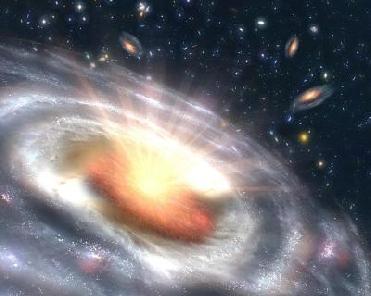
The word quasar is a contraction of quasi-stellar and means star like. But their light is very different from ordinary stars and it was first in the beginning of the 1980s that it was discovered that they were heavy black holes in the middle of a galaxy in the very early universe. NASA photo
NEW DELHI (BNS): A new research conducted by an international team has discovered likely primitive first-generation quasars.
Quasars are active and very powerful black holes at the centre of distant galaxies. The black holes are extremely massive weighing between 100 million and 10 billion solar masses.
Marianne Vestergaard, astrophysicist at the University of Copenhagen, in a statement said most galaxies have a massive black hole with a mass of over a million solar masses, but quasars are different with their black holes active and growing.
The gravity of the black hole gradually pulls the surrounding material of gas and dust into the black hole, which consequently slowly grows heavier and larger.
The disc of gas and dust is also resupplied with material from the galaxy, so the quasar can grow into some of the most massive objects known in the universe, second to galaxies.
But quasars have always resembled each other!
Together with colleagues from the US and Germany, Marianne observed 21 quasars in the distant universe, when it was only 800 million years old (it is currently 13.7 billion years old).
"With our new observations we could see that many of them had lots of hot dust, but two quasars did not -- they had no sign of hot dust, so we wondered why," she said.
In two of the most distant quasars there are indications that they reside in very young galaxy systems with less dust, where the black hole is growing rapidly.
For these distant black holes, the researchers see that the quasars without hot dust have small black holes, which devour gas at great haste, while the quasars with heavier black holes have more hot dust at the centre.
A possible explanation is that the black holes grow in step with the formation of stars in the galaxy. An increasing number of stars give an increasing amount of dust.
�It appears we have found what are likely primitive first-generation quasars, that are born in a dust-free medium shortly after Big Bang and are now seen at somewhat stages of evolution. With these quasars showing both rapid growth in both the black hole and the amount of dust, we may have found the young galaxy systems we have long been looking for," Marianne said.
 Previous Article
Previous Article Next Article
Next Article













The Indian Air Force, in its flight trials evaluation report submitted before the Defence Ministry l..
view articleAn insight into the Medium Multi-Role Combat Aircraft competition...
view articleSky enthusiasts can now spot the International Space Station (ISS) commanded by Indian-American astr..
view article